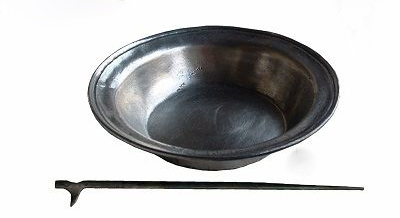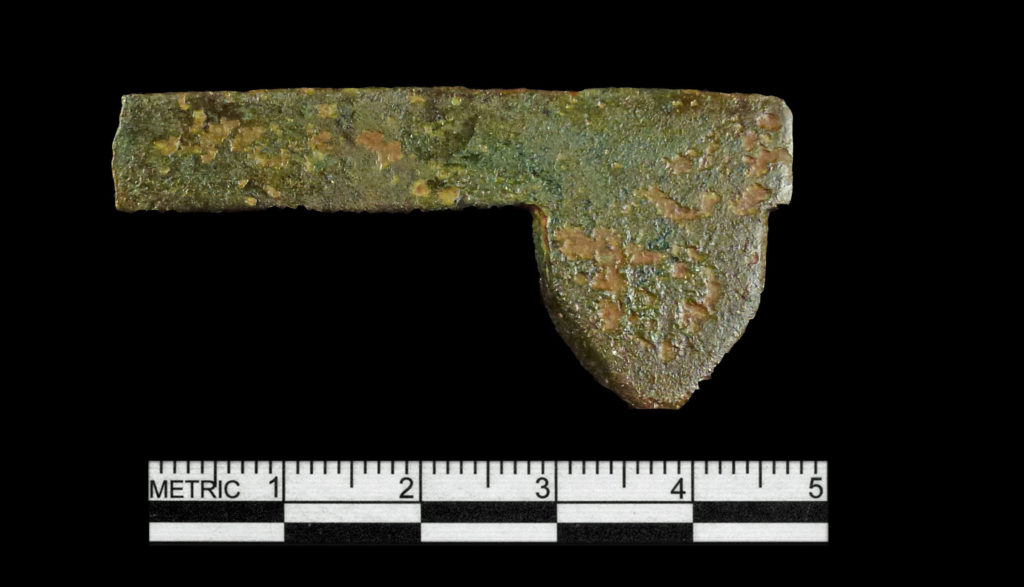Featured Fragment – Fleam Cover
By Kerry S. González
In the fall of 2012 Dovetail Cultural Resource Group (Dovetail) conducted a data recovery excavation on a mid-eighteenth through late-nineteenth century domestic site (7NC-F-135/Armstrong-Rogers) in New Castle County, Delaware. The data recovery was sponsored by the Delaware Department of Transportation (DelDOT) and the Federal Highway Administration (FHWA) as part of the DelDOT Route 301 study. Over 6,500 artifacts were recovered during the excavation, one of which was a copper alloy fleam cover (pictured below).
Fleams (pictured below), also known as bloodletting devices, were used in the historic medical practice of bloodletting. This instrument was a folding handheld device (much like a pocket knife) with several blades or lancets sharp enough to cut the median cubital vein at the elbow (Greenstone 2010). Once the blood flow began, a bowl known as a ‘bleeding bowl’ was placed under the arm to catch the blood.
Bloodletting as a medical practice is thought to have begun with the Egyptians around 3,000 years ago and grew in popularity throughout the centuries peaking in the nineteenth century (Greenstone 2010). During the third century B.C. a Greek physician named Erasistratus thought that all ailments stemmed from an excess of blood (Cohen 2012). By the second century A.D., Galen of Pergamum, also a Greek physician, believed that an illness was the direct result of an imbalance of the four “humors”, represented by liquids in the body, and the best way to restore balance was by bleeding (Cohen 2012). Furthermore, Pergamum believed each humor to be associated with the essential elements of air, water, earth, and fire as well as the four seasons of the year.
Blood=Air=Spring
Phlegm=Water=Winter
Black bile=Earth=Autumn
Yellow bile=Fire=Summer
The art of bloodletting became as ubiquitous as antibiotics are today in medieval Europe where physicians and even barbers began using the fleam, which at the time was an iron rod with a sharpened point that would get ‘hammered’ into the vein (Cohen 2012). In 1978 Saturday Night Live aired a satirical sketch (shown below) on bloodletting called “Theodoric of York: Medieval Barber.” During the sketch Theodoric orders 2 pints of blood to be removed from a sick woman stating: “Isabel is suffering from an imbalance of bodily humors” (Martin 1978). In the sketch the woman died, not unlike many real patients who were subjected to bloodletting.
Bloodletting continued through the years with historical figures such as Marie-Antoinette and George Washington reportedly being subjected to bloodletting. By the late-nineteenth century new medical practices were being discovered and luckily bloodletting as a treatment for all ailments became less frequent. While used today for conditions such as hemochromatosis (disorder leading to abnormal iron accumulation in organs) and polycythemia vera (stem cells bone marrow disorder causing red blood cell overproduction), we can count on never having to hear our doctor say: “you are in need of a good bleeding; let’s take 2 pints” (Greenstone 2010).

Reproduction of European Medieval Fleam and Bowl Based on Archaeological Finds at The Abbey Of Saint Eutizio, Italy (N.R.C. 2017).
Any distributions of blog content, including text or images, should reference this blog in full citation. Data contained herein is the property of Dovetail Cultural Resource Group and its affiliates.
References:
Cohen, Jennie
2012 A Brief History of Bloodletting. Electronic documentation, https://www.history.com/news/a-brief-history-of-bloodletting, accessed June 2017
Ebay
2017 Antique Baldinelli Veterinary Blood Letting Brass Cased Fleam. Electronic documentation, https://www.ebay.com/itm/Antique-BALDINELLI-Veterinary-Blood-Letting-Brass-Cased-FLEAM-5-Blades-Tools-/282525911312, accessed June 2017.
Greenstone, Gerry MD
2010 The History of Bloodletting. British Columbia Medical Journal (BCMJ) 52(1):12‒14. Electronic documentation, https://www.bcmj.org/premise/history-bloodletting, accessed June 2017.
Martin, Steve
1978 Theodoric of York: Medieval Barber. Saturday Night Live: Season 3. Electronic document, https://www.nbc.com/saturday-night-live/video/theodoric-of-york/n8661?snl=1, accessed June 2017.
N.R.C
2017 Reproduction of European medieval bloodletting and cautery tools based on archaeological finds at the abbey of Saint Eutizio, Italy. Image source: Medieval Design. In Pinterest [Personal Page]. Electronic document, https://www.pinterest.com/pin/132152570287486399/, accessed June 2017.


